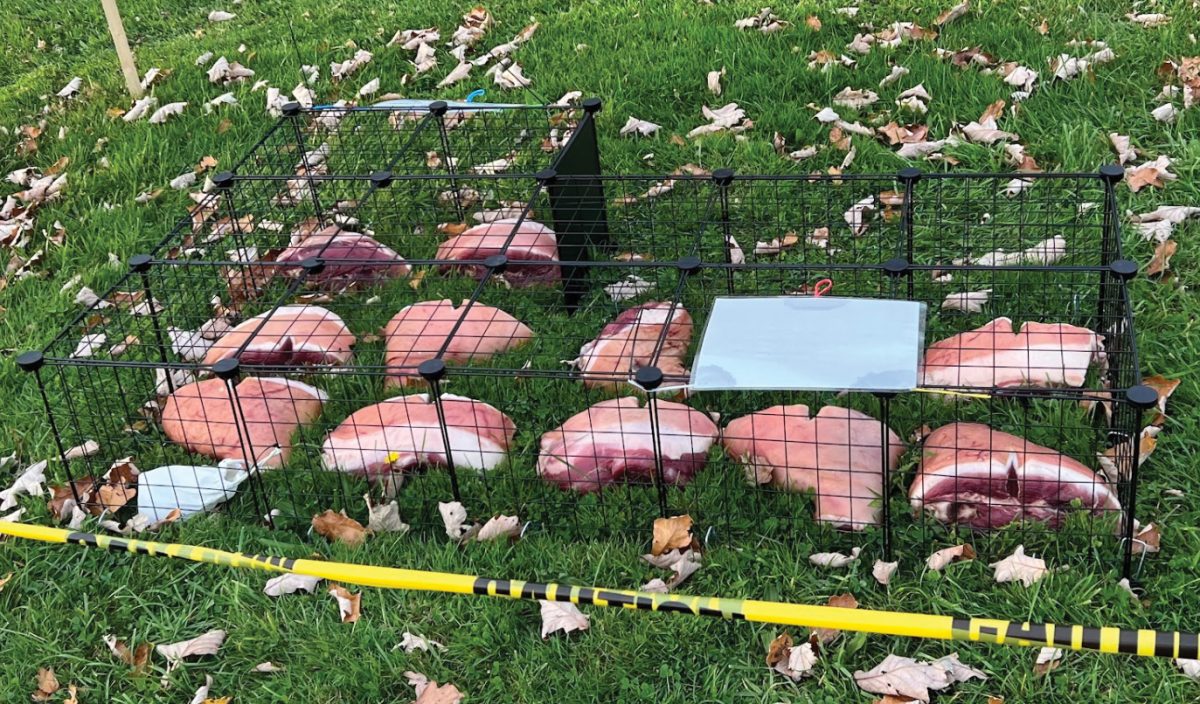Students of RWU might notice something grim next to the Rugby field, adjacent to Shell
Path: pig meat, cut up into large chunks, sitting in the grass and enclosed in a metal cage to ward off coyotes and birds. If one approaches the caged meat, they will see laminated paper signs fastened to the grotesque arrangement: “Approved forensic science department decomposition experiment,” “please do not disturb.” Indeed, these chunks of pork serve an educational purpose.
Sitting there, baking in the sun, soaking in the rain and gorged on by flies, the pig meat has one duty: to decompose. It was assigned this job by one of RWU’s seniors: Samantha Riley, a Forensic Science major. This is her capstone project.
In the beginning of October, Riley put her project out by the Shell Path, the only place that the environmental health and safety department would let her put it. The idea, though, began much earlier – all the way back in December 2022, Riley spent a while deciding what exactly she wanted to do. At first, the project was much larger: she wanted a full-sized pig, but this was not possible due to how much it would cost. She was limited to around four hundred dollars, and a full-sized pig would set her back nearly nine hundred. Riley had gathered funding from various departments in Roger Williams University to support her capstone project, and eventually settled on the most cost-effective solution, which was to use portions of a pig rather than a whole pig. She chose to use pig legs because that is the meatiest part of the pig. The idea of the project, according to Riley, is to “study in real-time whether it is possible to use the comparison of internal versus external tissue decomposition to discern a perimortem sharp-force trauma wound from a post-mortem mutilation infliction.”
The project is the first of its kind at RWU, as no one else has done this type of research before. “The project focuses on structural decomposition,” Riley says. Last year, another Forensic Science student had done a similar project involving the idea of studying microbes to discern time of death using a chicken carcass, but this project is quite different. So far, every four weeks since the pig meat was put out, Riley has been checking on it and making qualitative observations. Eventually, when the decomposition is mostly complete, Riley will take down the metal cage and the wooden posts around the meat and dispose of it all, ending the experiment.
As far as clean-up, Riley says, “I have protocols from environmental health and safety that I have to follow.” These protocols include triple-bagging what is left of the pig meat, throwing it away in a special dumpster, then hosing down the area with water. At first, when the meat was put out, it was not considered a biohazard, but since it has rotted, it must be treated as a biohazard and disposed of properly. Overall, it is an exciting and interesting project spearheaded by Riley, and it will certainly not be forgotten by the students of RWU.








